The following 30 plants that grow in water provide something for all needs and tastes.
Whether you’re looking to grow houseplants indoors, pond plants in your water garden, or even vegetables and herbs in your kitchen there’s plenty here to consider.
I’ll show you how to get started, and the essential information you need to know about growing each plant.
Let’s dive right in.
10 House Plants That Grow In Water
While any houseplant can be propagated in water, not all of them will thrive. Let’s take a look at some that will:
Chinese Evergreen

This tropical plant has become a household favorite with novice and expert indoor gardeners alike.
Why? Because it’s one of the most durable and easy to care for house plants you can grow.
Poor light? No problem.
Dry air? No problem.
You don’t even have to water it much and it still thrives.
Cuttings can be used for propagating new plants and will root in water:
- Cut 6 inches from the end of the mother plant towards the end of spring or the beginning of summer.
- Make sure that the cut is made just beneath a set of leaves.
- Then remove the leaves growing on the bottom half.
- Place the cutting in a glass containing water.
- Place on a windowsill where it can get moderately bright light.
After 2 weeks you should see roots starting to grow. Once they’ve grown to at least ½ an inch you can transplant the cutting to soil if you want.
If the plant starts to become too large as it grows, then you can trim it back to size. Giving you more cuttings to use for propagation.
Being a tropical plant, it does prefer warm temperatures, with around 70-72°F (21-22°C) being preferable.
When you place some plants in water they react badly to chlorine. So it’s a good idea to fill your vase or container with tap water and leave it standing overnight. This allows the chlorine to evaporate out and the water to adjust to room temperature.
This is also good advice for all the plants that follow.
Coleus
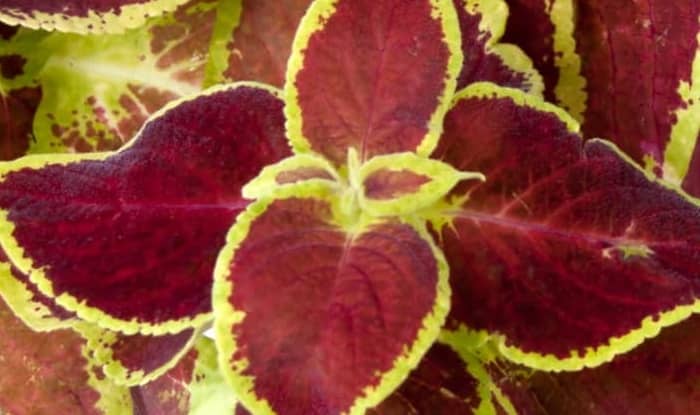
Coleus is an eye-catching plant that demands attention in any room or garden.
With its bright and brilliant leaves, that come in many different colors depending on the variety, it’s a firm favorite with gardeners looking to fill shady garden areas.
It grows easily in water:
- First, pick a long apical stem that has a bud at its end.
- Take a 2-6 inch cutting beneath a leaf node.
- Use your fingers to pinch off the lower leaves on the stem.
- Place the stem in a glass of water.
- Keep on a windowsill in the light.
When you remove apical stems from mature plants two new stems are produced by the plant. This creates a more bushy growth and appearance, which is something that many people prefer.
Although they don’t grow as quickly when placed in water as they do in the soil, Coleus cuttings will grow for a number of months when propagated in this way. They start to develop roots and eventually bloom.
As they are tropical plants, they grow best in warm temperatures at around 70-75°F. And starting cuttings indoors in water during the winter is a great way to start some new plants in preparation for planting in the spring.
Wandering Jew
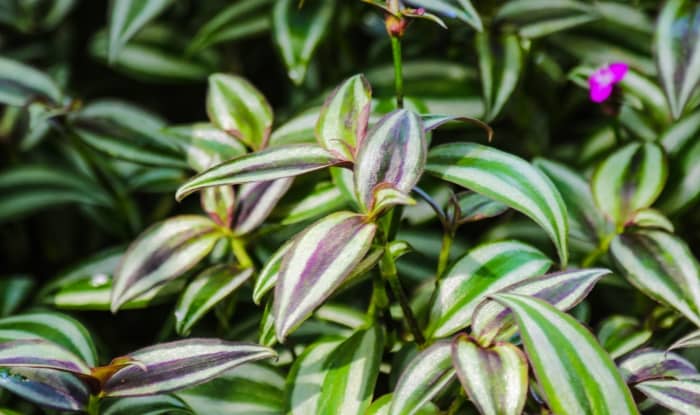
Wandering Jew is a quick growing plant with trailing stems and purple and green leaves, sometimes with silvery stripes.
As a warm climate plant, it’s a favorite with indoor gardeners. And it’s also among the easiest house plants to grow.
Its name is thought to refer to the plant’s habit of migrating to wet and moist areas. Inside the house, it also grows well in water, and it’s simple to propagate from stem cuttings:
- Take a 4-6 inch cutting from a mature and healthy plant.
- Make the cut just beneath a node.
- Remove the leaves from the bottom of the stem.
- Place it in a glass jar or vase with a narrow bottom and wide top.
- Make sure the leaves are above the rim of the vase and that there are no leaves in the water because they will rot.
- Place in the light, but avoid too much direct sunlight as it can prevent rooting.
- Keep an eye on the water level and replace it as needed, making sure the roots are always kept underwater.
Wandering jew thrives between 65-75°F, but it will grow okay in warmer temperatures as well. Below 50°F, its leaves can look damaged and discolored.
Geranium
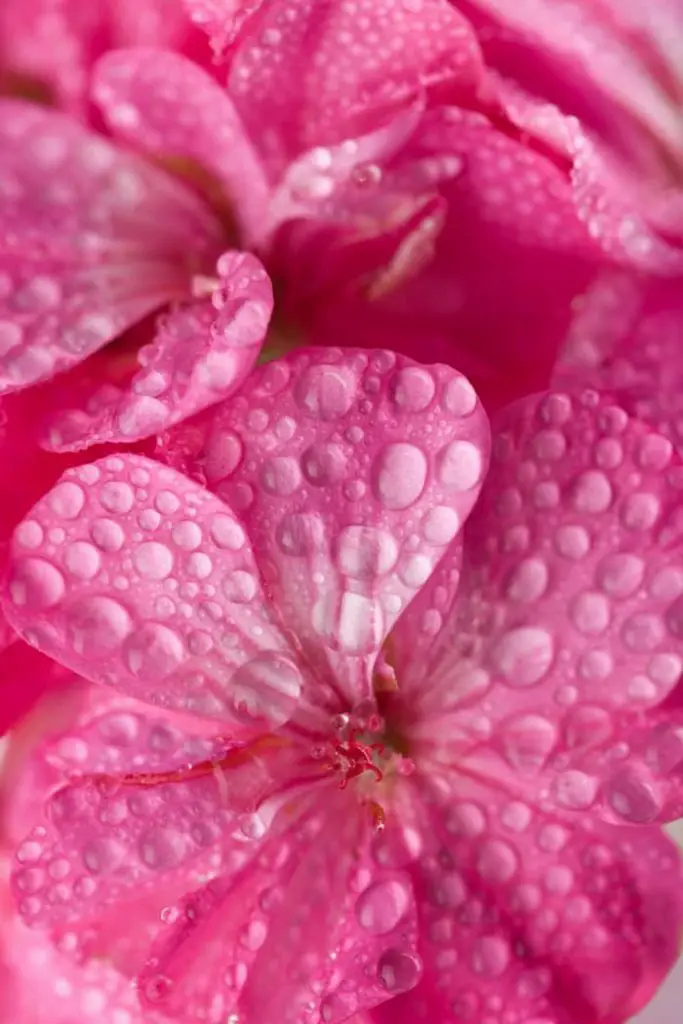
Prolific, hardy, and easy to care for, Geraniums are near the top of the charts when it comes to house plant popularity.
With their colorful flowers and scented leaves, they make a beautiful addition to any home or garden.
It’s easy to start Geraniums from cuttings:
- Start with a healthy growing plant and take a 4-6 inch cutting from below a leaf node.
- The cutting should come from a leaf stalk and not a flowering stalk.
- Remove all leaves apart from the ones at the very top.
- Put the cutting in a vase of water, making sure there aren’t any leaves below the waterline.
- Place the vase somewhere light but without exposing it to direct sunlight.
After about a month Geraniums should start to root. Leave them for a further 2-3 weeks to allow the root system to become strong before you consider moving them into soil.
Geraniums grow throughout the year. And unlike many other plants, there’s no need to wait for a specific time of year to propagate them.
However, the best time to take cuttings is in the late summer while plants are growing. You can then overwinter them indoors.
Peace Lily
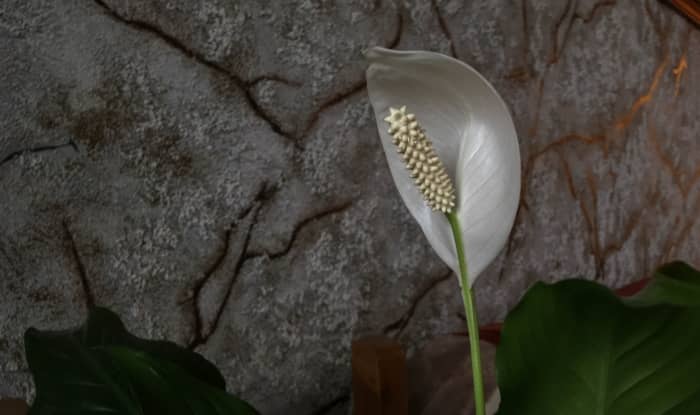
It’s true that Peace Lilies don’t live as long in water as they do in the soil.
But they do adapt. You’ll see them develop a number of very small roots that feed the plant. Rather than the large roots designed for extracting nutrients out of the soil.
There’s a number of steps to carry out:
- First, take it out of its pot.
- Inspect the plant and remove any damaged or rotting roots using a pair of shears.
- Then wash the roots to remove any clinging particles of soil until they can be clearly seen.
- Add the lilly to your vase of water.
- Change the water every two weeks.
- Leave the plant and vase out of the sunlight.
Make sure to add a few drops of fertilizer to the water every couple of weeks to provide nutrients and keep it in good health. Many people like Miracle Grow.
If you can, get a plastic stopper that fits in the vase and cut a hole in the middle. You can use this to keep the lilly in place when you insert the roots into the water. Make sure that the roots are fully submerged.
English Ivy
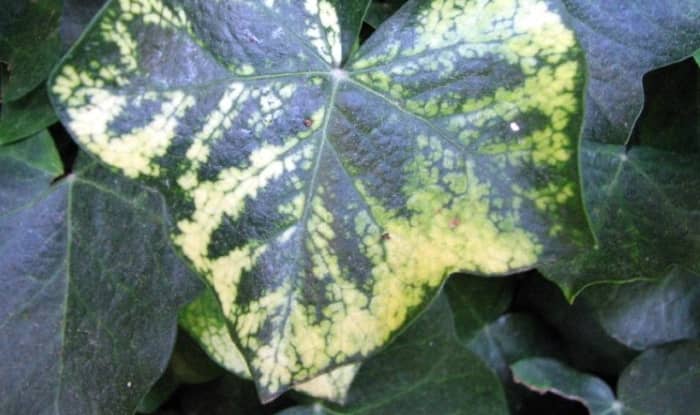
Source: Jean
Ivy makes an interesting and attractive houseplant. It grows lush and long and can add a wild outdoors feel to the inside of your house.
It’s simple to grow as long as you know how to keep it happy. The most important thing is to make sure it has plenty of bright light. Because without sufficient light ivy plants start to look sickly. They also become more vulnerable to pests.
To get started:
- Prepare by watering the original ivy plant the day before you intend on cutting it
- The following day, snip about 6 inches off the end of the stem. Making sure you include at least 3-4 leaf sets.
- Next, remove the 2 sets at the bottom and put it into a vase, leaving only the stem in the water.
- Leave the cutting somewhere warm and light, but not in direct sunlight.
It’s best to use transparent glass. Not only will you see when it’s rooting, but you’ll also be able to see when it’s time to change or top up the water.
After a 4-6 week period, the ivy will have sufficient roots that you can plant it if you want to.
Ivy grows long, but you can easily prune it to a manageable size. Make sure that you cut it ¼ inch above the leaf node. This keeps the root system intact.
Pothos
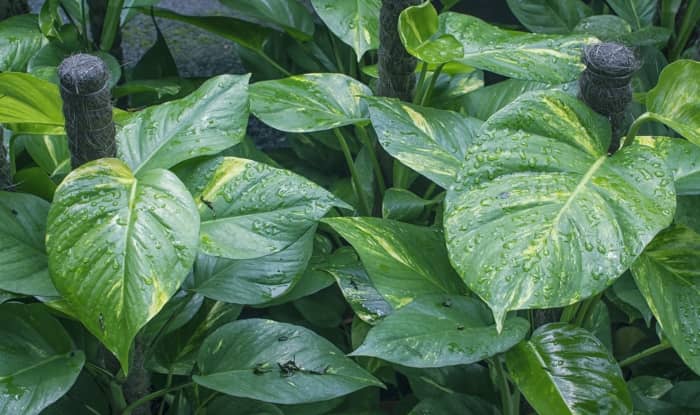
Also known as Devil’s Ivy, Pothos is one of the best plants for beginners. It’s simple to care for, and has a wild and attractive appearance with its trailing vines and large green tumbling leaves.
They thrive in bright indirect light, low levels of light, and even in low nutrient environments.
You can take cuttings from a mother plant and root them in water. However, plants that have been grown in soil can struggle to make the transition to water and vice versa.
Here’s how to get started:
- Take a cutting by snipping directly beneath a leaf node (the little brown bumps visible on the stem). Make sure you have a stem with a minimum of 3 nodes.
- Snip off the leaf that’s nearest to the bottom of the cut stem.
Place the cutting in water making sure that the cut stem is completely submerged. - Leave near a window, but not in direct sunlight.
- Refresh the water once every week or two, and add some liquid fertilizer.
If you want to transplant your pothos plant from the water to the soil, wait until it has at least an inch of roots. This usually takes around a month.
Be aware that the plant will continue to grow roots if it’s left in the water. But the longer you leave it growing in the water the more difficult it will be to move it successfully to soil.
Philodendron
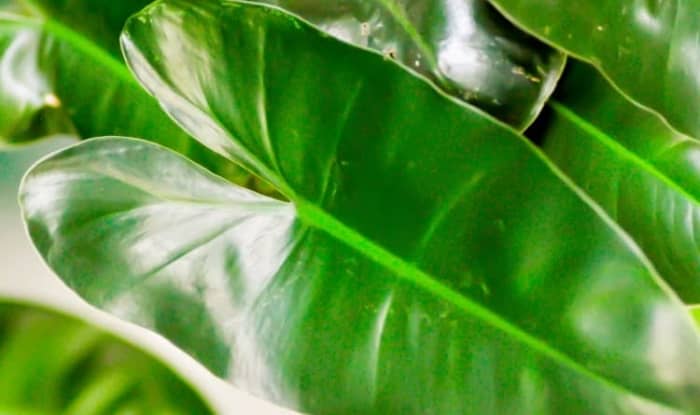
Philodendrons are another easy to grow house plant that are very forgiving for the beginner or the forgetful. Seriously, if you kill this plant, we’ve got to have words 😉
They come in many different and beautiful shades, and can be grown and kept as trailers or as bushy plants.
They easily adapt to growing conditions inside, where they thrive all year round. And it can survive even if you rarely change the water.
Let’s take a look at how you can get started:
- Cut a 6-inch stem from the end of the mother plant, making the cut close beneath a set of leaves.
- Remove a couple of sets of leaves from the bottom of the stem.
- Put the end you removed the leaves from in a glass of water.
- Try to replace the water once every week or two.
After about 4-6 weeks you should start to see new roots grow from the nodes. At this point, you can take it out of the water and plant it in soil if you want. Or you can leave it to continue growing happily in the water.
Keep an eye on the water level in the vase. The growing plant will consume water through its roots and some of it will also evaporate. You should try to make sure that the roots are immersed in water at all times.
They can live for a long time in water or you can transplant them to soil. But remember to keep them in the warm. Philodendrons are tropical plants, and they don’t take too kindly to the cold.
Although they can grow in all light conditions, if it looks like you’re not getting a lot of leaf growth on the stem putting them in a brighter place will usually help.
Older leaves will sometimes turn yellow. But if you notice this happening to many leaves simultaneously then it’s possible that the plants may be too exposed to the light.
Begonia
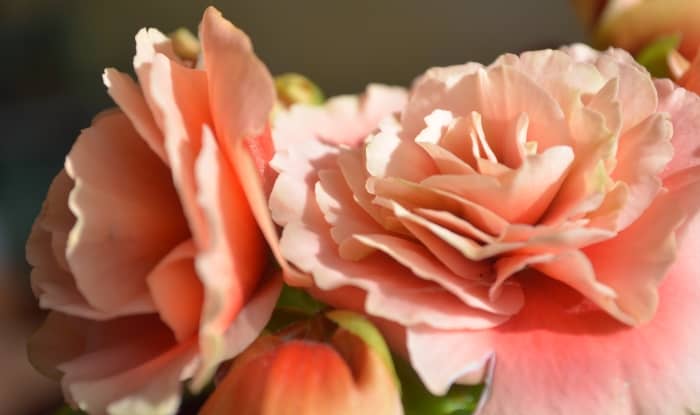
Begonias are one of the easiest plants to root from cuttings, and they take to water like a dream. Allowing you to keep a hint of the summer inside your house throughout the year.
Although there are many different species of begonias the procedure to propagate them in water is very similar:
- Choose a healthy Begonia plant that has become long and thin, with a large expanse between leaves on the stem.
- Take a cutting that is about 4 inches long snipping just beneath a node.
- Remove the leaves, just leaving a couple at the top of the stem.
- Also, remove any flowers that are present.
- Place the cut end of the stem into a container of water.
- Use a small container of water. The cutting will release a rooting hormone into the water and the smaller the volume the more concentrated this will be.
- If you want you can place several cuttings in the same container of water.
You can expect to see roots forming within a month. But you should wait until they are at least a couple of inches long before removing them from the water and putting them in soil.
You can leave them in the water if you want though, they’re quite happy with it for long periods of time.
Lucky Bamboo
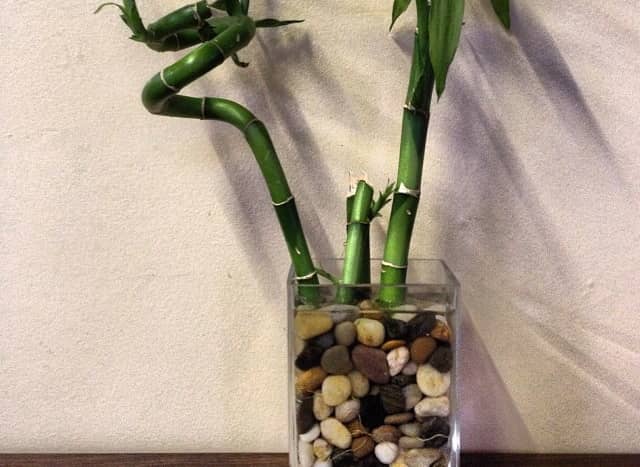
Source: Veritatem
Did you know that although the stalks of the plant resemble bamboo canes, it isn’t actually bamboo at all?
It’s true. Lucky bamboo is a dracaena, or Dracaena sanderiana or braunii if we’re being specific.
Commonly used in feng shui, it’s had importance in Chinese culture for thousands of years. Although its popularity has risen quickly in recent times and it’s now common to find it all over the world.
Different meanings are given to the different numbers of stalks. 3 is the magic number. It represents good fortune, particularly when received as a gift. But it’s important to stay away from 4. That’s bad luck in Chinese culture, so be careful about giving it as a gift!
Caring for it is easy. And because of its tough stalks, it’s developed a reputation as an extremely durable plant.
Here’s how to grow it in water:
- Get your container of water and layer some pebbles in the bottom to provide support for the plant.
- Make sure you have enough water in the vase to cover the roots. 1-3 inches is usually sufficient.
- Replace the water every 2-4 weeks, cleaning the pebbles and container as well. Make sure to keep an eye on the level and add more if needed.
- It usually grows okay without adding fertilizer, but you can add a few drops each month if you wish. There’s a product that’s specially formulated for Lucky Bamboo called Super Green.
- Keep it in bright, but indirect light.
- It likes warmth, so try to keep it above 65 °F.
It’s very sensitive to chlorine. So the advice to leave your container of water standing overnight most definitely applies here if you want to have a healthy plant.
Something else that’s important to be aware of: the leaves of this plant are known to be mildly toxic, so don’t let your pets chew on them!
5 Vegetables You Can Regrow In Water
Before you throw away your left-over vegetable cuttings after cooking, take a second to consider their potential. You can still put them to good use.
You’d be surprised just how many you can regrow and it’s simple to do. It’s a great option for people who don’t have the garden space to grow their own outside.
Here are 5 of my favorites that you can grow indoors just using water:
Carrot Tops
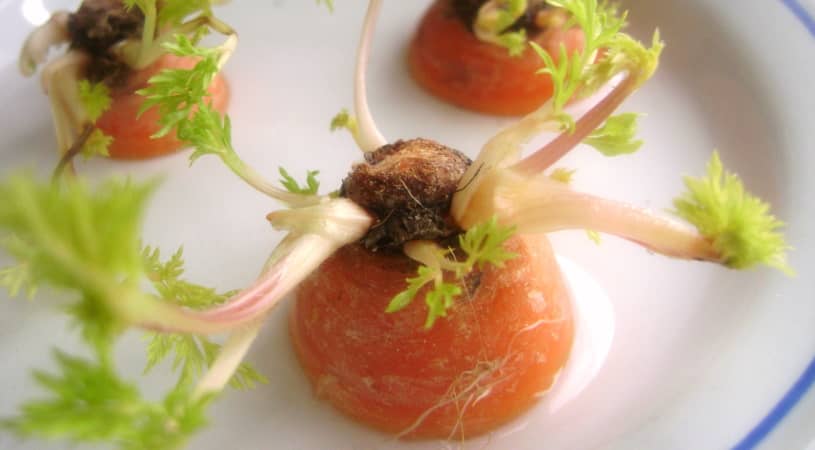
Source: Renee
While it’s not possible to regrow a whole carrot in water, you can regrow the tiny green leaves from its top. Many people throw these away after they’ve finished chopping the vegetable, without realizing there’s more you can do.
They make a nice addition to salad or chutney. And you can make carrot top pesto with them.
To get started:
- Line the bottom of a shallow dish with cotton balls.
- Leave approximately 3 inches at the base of the carrots when preparing your vegetables, with some of the root still at the top.
- Put these left-over pieces face down on the cotton balls.
- Lightly water the cotton balls so they’re moist, but don’t drown it in water.
Leave it on a windowsill where it can get sunlight, and after a few days you should see the greenery sprouting from the top.
Lettuce
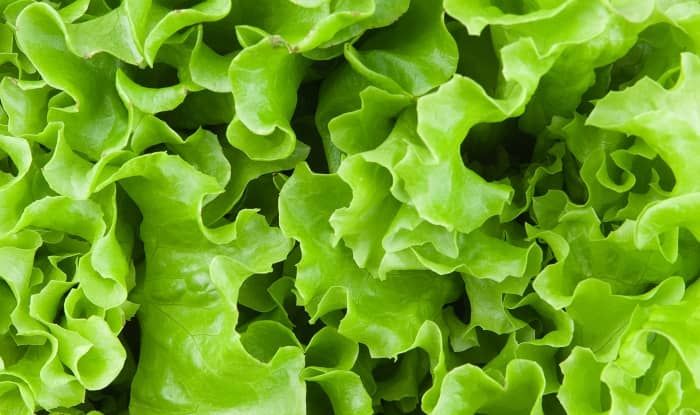
Did you know that lettuce can be regrown from its stems?
It won’t regrow to the same size as before, you’ll get a small portion from each stem of lettuce you start with.
Romaine lettuce is the best to try this with. And it’s simple to do:
- Cut the leaves off your lettuce leaving about an inch at the bottom.
- Fill a shallow dish with about a ½ inch of water.
- Place the lettuce stem in the dish with the cut side facing up.
- Change the water each day.
You’ll be surprised at how fast it grows back. And within a few days, you’ll have enough new lettuce to use.
But don’t grow it longer than about 10-12 days. It won’t get much bigger from there. And if you grow it too long it loses its pleasant taste and becomes bitter as it tries to produce seed. It’s easy to tell when it’s got to this stage by the blue-green color of the leaves.
You can also do the same with other leafy vegetables such as cabbage.
Green Onions
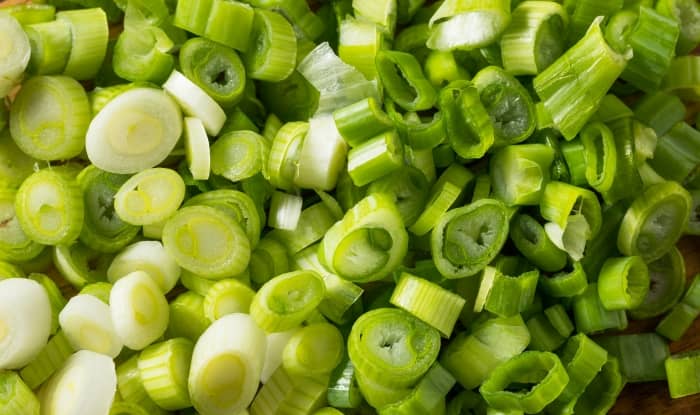
There are so many recipes where green onions come in useful, salads, pasta, quiche, pancakes, and much much more. So it’s a shame to throw them away when you can grow them fresh at home.
And it’s really easy as well. A transparent jar or glass, a windowsill that gets some sun, and some left-over green onion roots are all you need:
- After you’ve chopped off the onion leaves make sure to leave the bulb with an inch or more of green stem above.
- Place its roots down in a transparent glass or jar that will allow sunlight to get to the left-over plant.
- Half fill the glass with water.
- You can fill the glass with multiple bulbs if you want but don’t cram them in too tight.
- Leave it on a sunny windowsill that’s exposed to the sun for at least 4 hours each day.
- Change the water every couple of days.
Within a few days, you’ll start to see new shoots growing. And after 1-2 weeks the bulbs will sprout new leaves that you can use for food again.
Beet Greens
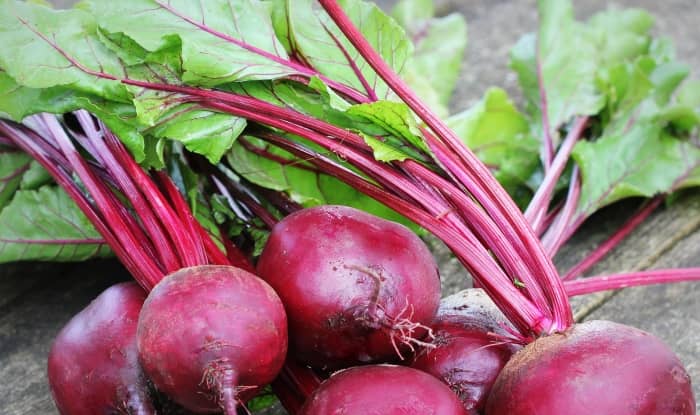
Beetroot is well-known as a very nutritious vegetable. But although often discarded, it’s green leaves are also great for your health.
They’re high in vitamin A, which is important for your immune system. And have a greater iron content than spinach.
So it would be a shame to let them go to waste, particularly when there’s so much you can use them for. They make a great addition to soups, salads, cooked vegetable dishes, and pasta.
They can be grown easily indoors from your scraps:
- Fill a small dish with water.
- Take the leftover top portion of a beet and place it cut side down in the water.
- Leave the dish on a windowsill where it can get sunlight.
- Change the water every few days to keep it fresh and stop bacteria from growing.
- The greens will begin to grow and you can harvest them when you need them.
Make sure the beet top doesn’t sink beneath the water’s surface. This is where using a very shallow dish and a small amount of water is useful.
Bok Choi
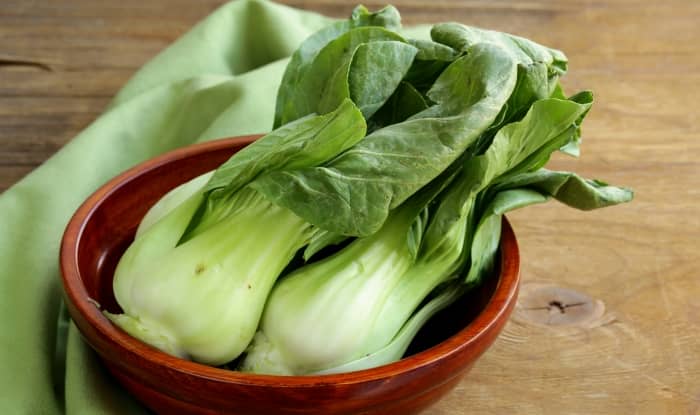
Bok Choi, also sometimes called Chinese Cabbage, is a green vegetable that you can eat cooked into food, or raw in a salad. It’s particularly popular in Asian cuisine, and contains lots of essential vitamins and minerals.
To regrow:
- Use the left-over base of the stem after you’ve cut all the leaves off.
- Place it face up in a small bowl of water.
- You’ll see the difference overnight as it starts to regrow from the base center.
Then you can either use the new leaves that have sprouted or transfer the Bok Choi into a container to continue growing the plant.
10 Herbs That You Can Grow In Water
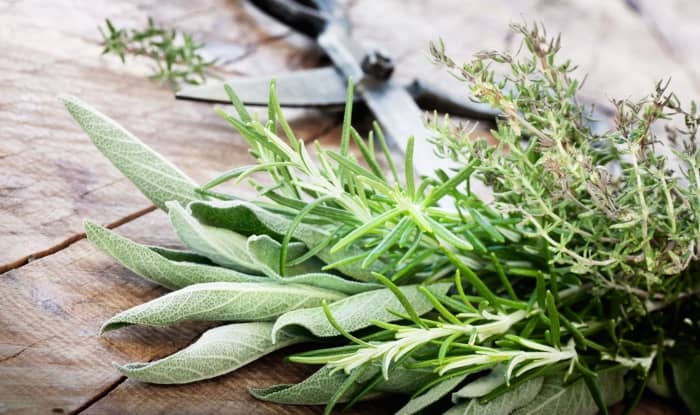
Did you know that you can grow your own supply of organic herbs at home on your own kitchen windowsill?
Rather than using soil and planters you can have your own little herb garden arranged in arow of vases without the mess or hassle.
Which is great news for the winter months if it’s too cold outside for them to grow.
It’s not possible to grow all herbs in water. But those herbs that will are usually perennials. They will keep producing more leaves as long as you keep removing the old ones as they grow to their full size.
These are some of the ones that will:
- Basil
- Oregano
- Thyme
- Mint
- Sage
- Rosemary
- Chives
- Stevia
- Lavender
- Lemon Balm
How To Get Started:
Firstly, you’ll need to get colored or opaque glass containers. Herb roots don’t like exposure to sunlight. But the plants themselves do, so it won’t work to keep them in shade.
The containers need to hold your stems upright. So a good option is to get ones with a narrow neck. You can also cover the top with netting, or use a plastic stopper with a hole in it to hold the herb stem in place. Just be careful not to use too narrow a jar as you will need to clean them and you need to allow enough room for the herb to grow.
Leave the water to sit for 24 hours to allow the chemicals to evaporate out. Then follow these tips:
- Take cuttings off fresh herbs from the store.
- Cut 4-6 inches from the stem by cutting below a leaf node. Try to snip a stem that already has 1-3 leaves sprouting.
- Remove the leaves from the part of the stem that will be under the water.
Most herbs root quickly. But some of the ones with woody stems, like Rosemary, can take as long as 6 weeks before roots grow.
Dipping the cut ends in rooting hormone can help speed up the rooting process and increase the likelihood of success.
You’ll need to add a water-soluble fertilizer to the water to provide the herbs with the nutrients they need to continue to grow.
5 Plants You Can Grow In Ponds
If you’re looking for some decoration for your garden pond you’ll need plants that are specially adapted to growing and thriving in water.
Growing pond plants is a great opportunity to try out a variety of plants that you wouldn’t otherwise get to enjoy.
They come in a number of categories:
- Deep-water plants – Pot them and place the pots on the bottom of the pond.
- Floating plants – Grow without soil and get their nutrients from the water.
- Submerged plants – As it says, the plants are entirely submerged.
- Marginal plants – Grow around the margins of ponds in the shallows.
Here are some popular options for you to try:
Water Lilies
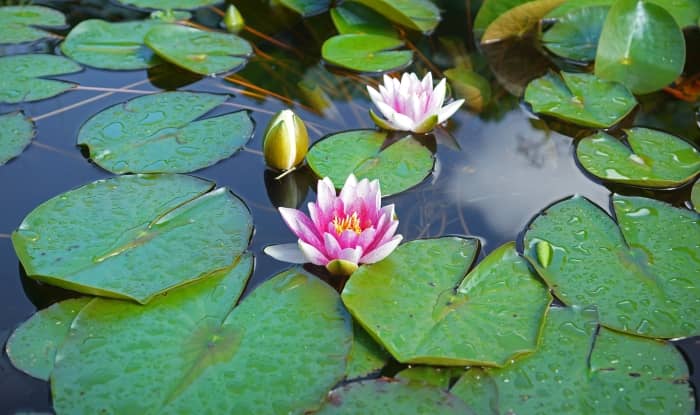
The water lily is a deep-water plant. It has large leaves (or lily pads) that are just as important to the plant’s aesthetic appeal as the flowers.
Don’t let the deep-water classification put you off, lilies can be grown even in shallow ponds of around 10 inches deep.
Although their roots are underwater, like many pond plants they still need soil to grow in. The easiest way to do this is to grow them in pots that you then submerge.
Try not to use a potting mix, as it won’t remain submerged easily and will muddy the water. Instead, choose a soil that contains a mix of sand and clay. After you’ve put the plants in their pots, cover with a layer of gravel or small stones before you place it in the water.
Water Lettuce
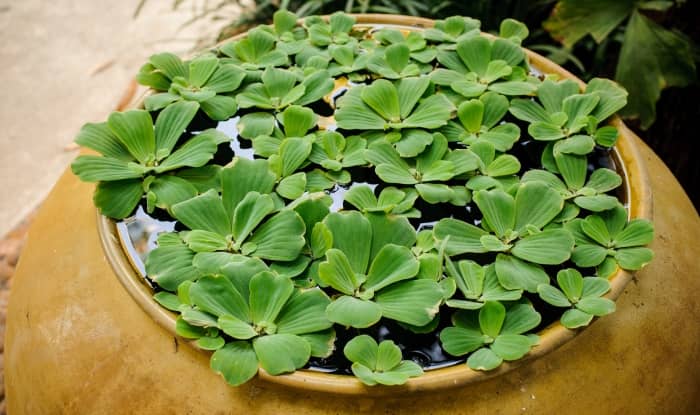
A good example of a floating plant, water lettuce is visible on the surface of ponds as a rosette of lime-green leaves that resemble floating heads of lettuce.
The plant floats on the water while its long roots dangle in the water below, sucking up nutrients, and providing a safe haven for small fish.
These plants are great for beginners as care is minimal. Just make sure that they’re getting sunlight, although they do grow better in part-shade.
Propagation is simple and just involves division. You simply separate the baby plant (with roots) from the mother plant with your hands and let it float freely on its own.
Northern Blue Flag
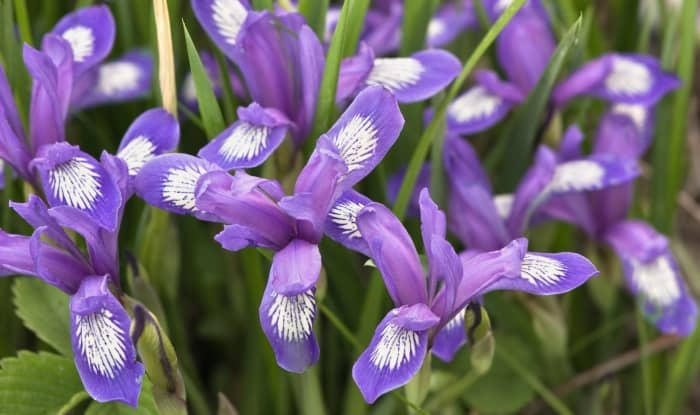
Northern Blue Flag is a marginal plant that will add a real injection of color to your garden pond.
It has bluish-green leaves that are narrow and sword-shaped. With each stalk bearing up to 5 violet-blue flowers with a white and yellow patch in the center. The eye-catching flowers can span up to 4 inches across.
A member of the iris family, it can often be seen in the wild in forest wetlands and on the banks of streams.
But it’s an easy plant to grow at the edge of a garden pond. And can stand in up to 6 inches of water in locations that have at least some exposure to the sun.
Pickerel Weed
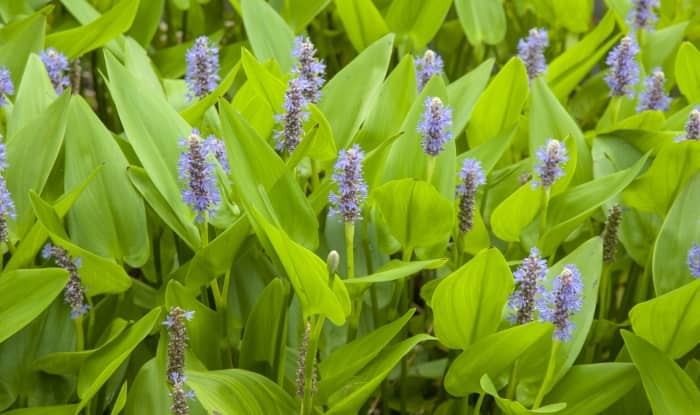
Pickerel is a semi-aquatic plant that grows in clumps with glossy dark green heart-shaped leaves and attractive spiked blue flowers.
When partially submerged in water it has floating leaves that can prevent excessive algae growth due to the shade they create. They also provide foliage for fish to hide in.
You can plant it directly in your pond. Or in planters or pots. It can be invasive because of its rhizomatous rooting system. But if you plant it in submerged pots you can prevent it from spreading and taking over your pond or garden.
Caring for them is easy as they can tolerate most conditions except full shade and drought. If stems begin to turn brown or yellow then you can remove them yourself to prevent them falling into your pond.
Horsetail
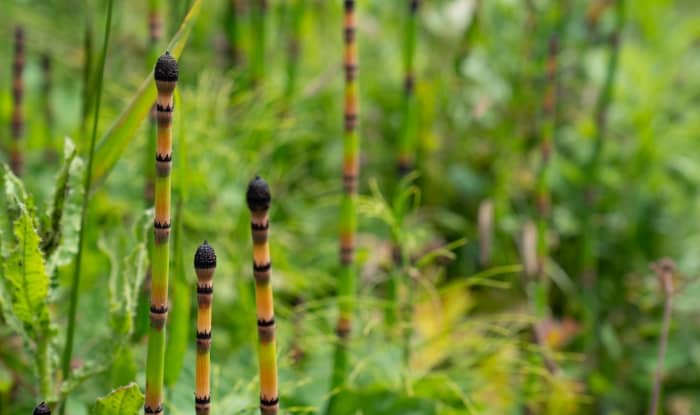
With its deep green, jointed stems, and stalks that bring to mind bamboo, horsetail adds an interesting tropical look to a water garden.
Its tall and slender stems grow to 24 inches in height and bear no leaves or flowers. They look great on the edge of ponds, where their height creates a vertical interest.
This plant is an evergreen perennial that grows by runner. It’s best kept in pots or planters or its aggressive spreading can start to take over your garden and it’s difficult to get rid of even with herbicides.
Horsetail can grow in standing water of depth around 3-4 inches and in almost any soil type.
Taking Care Of Water Grown Plants
Water doesn’t contain many nutrients. And what little there is will be used quickly by your plants. As they can’t get access to nutrients they would normally extract from the soil you need to help them. Liquid fertilizers can be added periodically, or you can buy formulations that are designed for hydroponics.
When using fertilizers to feed your water grown plants you may notice that residue can accumulate which can cause root burn. For this reason, it’s important to give them a change of water regularly. And occasionally rinse the plants and containers.
Another thing that some people like to do is add a layer of clay aggregate to the base of the container giving the roots some support. Known as LECA (Lightweight Expanded Clay Aggregates) these small clay pellets are very porous and help to provide oxygen to the roots as well as water.
This method of growing is known as hydroculture. Gel beads (water beads) are also a popular lining to use.
One of the things I love about growing houseplants in water is the convenience. If you’re someone who travels a lot and doesn’t have time to water your plants every day then this method is for you.
Or maybe you’re a beginner and find it hard to judge how much water your plants need when they’re in soil. Which sometimes leads to drowning them with too much or dehydrating with too little.
All you have to do is keep an eye on the water level and make sure you keep it topped up and changed when necessary. And fertilizers only need to be used occasionally.
Final Thoughts
There are many plants that grow in water. From houseplants that will add color and a touch of nature to drab household interiors. To pond plants that thrive in a wet environment and will complete the perfect picturesque water garden.
And don’t forget about regrowing your vegetables and herbs. It really comes in handy if you’re on a budget.
It’s easy to get started growing indoor plants in water. Many houseplants can be grown in jars and vases with little more effort than the occasional change of water, and a few drops of helpful liquid fertilizer.
So have some fun and experiment.
Do you have a favorite plant that you successfully grow in water? Let us know in the comments.
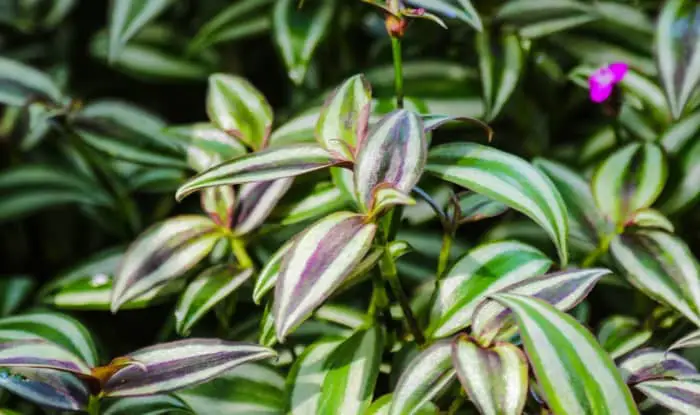
This is an informative and comprehensive article. I have often wondered exactly if some of these propagations could be made. Thank you
loved this very informative article
Celery works well and it is one of my favorites because it grows fast making it fun to watch. Our children love watching it grow.
Eat the top of the celery but save the base to regrow. The base will grow new roots and then new shoots.
This article is very helpful. I enjoy growing plants in water, i like watching the roots grow and leaves. I love plants altogether. Thank you for this article and the great advise.
Appreciate it.
Thanks for the suggestions. I took some geranium cuttings a few months ago and so far so good. It’s interesting to see the other plants in this list because I think there are a few I might want to try.